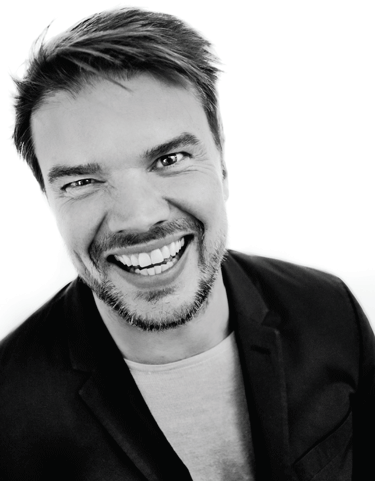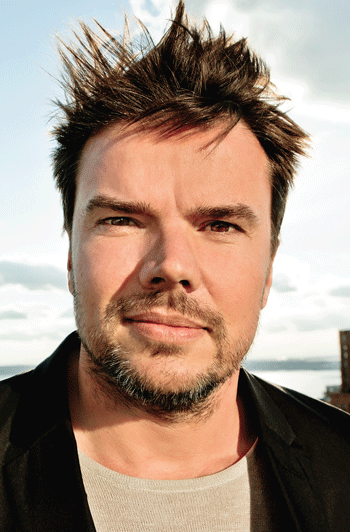Bjarke Ingels suffers from claustrophobia, which is perhaps an architect’s ideal malady.
“I’ve been stuck in elevators, and it requires a lot of mental discipline to get through it,” the 42-year-old architect tells me in his chaotic 33rd-floor office on Broadway in the Financial District. He’s dressed in a dark T-shirt and blazer, like a tech geek on his way to a fancy restaurant. He never combs his hair. “So it’s perfect to be in a business where you can create space, especially if the absence of space is what you are afraid of.”
Since arriving in New York in 2010, the Danish designer has had the opportunity to create a lot of space in one of the most congested cities in the world. He calls his move to New York “the least planned, most spontaneous and most impactful decision” of his life.
With only one major project underway in New York City, Ingels’s firm, BIG, was tapped to design 2 World Trade Center after the project was reassigned from Norman Foster’s Foster and Partners (that project is on hold until developer Larry Silverstein secures an anchor tenant). His first New York project, Via 57 West — developer Douglas Durst’s 467-foot “tetrahedron,” a pyramid-like rental project on the West Side Highway — is the kind of bold, big-budget building many architects work a lifetime without achieving.
Ingels famously got the commission after asking just one impertinent question at a green-building conference.
“We had a symposium with local architects, and there were no questions until Bjarke stood up and asked, ‘Why do all of your buildings look like buildings?’” Durst told me in a 2014 interview.
But it probably took more than charm for the firm to win its next commission. It beat out established city players for the right to design a key piece of Manhattan infrastructure. In 2014, BIG won $335 million in federal funds to create the Big U, a 10-mile buttress commissioned by the city to protect Lower Manhattan from another superstorm like Sandy.
“What was interesting about the project for someone who just moved to New York is that it has been this crash course in local politics and also understanding the different neighborhoods,” Ingels says, noting that the project touches both the wealthiest and the least privileged neighborhoods in New York.
And now Ingels is joining the ranks of the world’s most celebrated architects with a new luxury condo project along the High Line called The Eleventh. Developer HFZ Capital is bringing in Six Senses Hotels Resorts Spas to open a flagship hotel at the property.

The Eleventh
“It’s going to be pretty goddamn nice,” Ingels says of the two twisting towers rising over the elevated walkway between 17th and 18th streets. “It’s interesting because the High Line is one of the greatest things to have happened to New York in the last decade. To be part of that transformation is pretty interesting…It’s this sort of Pritzker Row of architects — with Frank Gehry, Jean Nouvel, Norman Foster, Renzo Piano, Richard Meier and Zaha Hadid.”
On the global stage, Ingels’s impact has been even more profoundly felt. He’s co-designing Google’s futuristic California headquarters with Thomas Heatherwick. In his hometown of Copenhagen, Copenhill,
a power plant with a ski slope on the roof, is almost complete. And in Dubai, he’s rethinking public transportation with Hyperloop One,
a superfast pneumatic train system conceived by Elon Musk.
Virtually overnight, Ingels has become one of the youngest and most important architects, based in one of the world’s most architecturally significant cities. He’s a darling of the media, Silicon Valley and academia. More than 20 different publications, including Rolling Stone, Wired and the New York Times, have called Ingels architecture’s “wunderkind.”

Google’s futuristic HQ in California
He’s design’s de facto cultural liaison, featured in a show called “Abstract” on Netflix, confounding many industry peers who are often critical of his “rock star” status.
Read comments on stories about Ingels or on Reddit — and it’s worth pointing out that Ingels is the kind of person who gets people on Reddit talking — and you’ll see architecture nerds laying into Ingels for ignoring “details,” for being overly individualistic in his approach and for acting more like a publicist for architecture than an architect.
“It’s just player-hating,” James Ramsey, the principal of Raad Studio and the man behind the forthcoming underground park on the Lower East Side, the Low Line, told me. People are always critical of successful visionaries who don’t play by the rules, he says.
“We got surprisingly successful quickly; that triggers a lot of backlash,” Ingels says. “I would love to do art museums and concert halls all the time. But I also love to do developer-driven apartment projects because at the end of the day, when you look out the window, 99 percent of Manhattan is not Lincoln Center or the Whitney…You have to cook with the ingredients that are given to you. But it doesn’t have to be Waygu beef in order to be haute cuisine.”
As far as the “wunderkind” label, he says it can’t last. You can’t be a wunderkind with gray hair, and he’s finding grays.

Ingels, center, with The Eleventh developer Ziel Feldman of HFZ Capital, left, and Neil Jacobs of Six Senses Hotels Resorts Spas, right.
“You can’t be trusted to do anything until you’ve already done it,” Ingels says. “That’s why it’s been a double-edged sword, this wunderkind label. Of course, it’s good for attention and it’s an easy thing to write, but it’s also been a struggle: If you look too young when you walk into the room, then you have to be even more professional and even more rigorous.”
But it’s true that you’re more likely to see Ingels giving a TED Talk, or partying at Burning Man or at one of Esquire’s “Breakout” dinners, than drawing in CAD. Time magazine included Ingels in its 100 Most Influential People in 2016. And he likes to impress party guests by changing the lights on Durst’s Bank of America tower with his cell phone. Martha Stewart asked me for his number.
Ingels doesn’t talk like an architect,
either. He relies on colorful metaphors, pop-cultural allusions (from comic books to “Game of Thrones”) and bad jokes instead of the normal academic formalities.
“I think there is something suspicious about clarity,” Ingels says. “I really want people in general to understand and appreciate what we are doing. We aren’t just designing for other architects. So I try to avoid jargon that is too inaccessible.”
Also unlike many architects who try to brand their work, Ingels says he doesn’t have a style.
“I just came back from Switzerland, because we are doing a museum and a hotel [for Swiss watchmaker Audemars Piguet],” Ingels says, pointing to a model of the project. “It’s hard to say what is the similarity between the architecture of this and my new building [on the High Line].”
If there is a stylistic connection, it’s conceptual rather than formal. Ingels’s work is incredibly varied, ranging from sweeping, asymmetrical planes to sharp, repetitive structures. All of his 30 or so buildings, however, are united in their playfulness, environmental consciousness and willingness to break with preconceived ideas of beauty.
“I think we are consistent in that our buildings look different, because they perform differently,” Ingels says. “We like to look at the specifics and try to find some kind of problem or potential, and that becomes what gives form to the project.”
But in the years since Ingels established his New York office, building it to over 200 employees, something has changed. BIG is starting to look and feel less and less like a cool startup and more and more like part of the architectural establishment. It’s looking, well, “big.” Ingels doesn’t disagree.
“We are being granted commissions that we didn’t have access to before. It’s the ultimate establishment move to do a big corporate skyscraper, and not just any corporate skyscraper but the corporate skyscraper,” Ingels says, referring to 2 World Trade. “We have been around for 16 years, and now there is just more evidence of what we are capable of.”
So how did Ingels become the overnight face of architecture 2.0?
Three names: Frank Miller, Friedrich Nietzsche and Rem Koolhaas.
* * *
In 2009, Ingels published his manifesto, “Yes Is More.” The title is a play on architect Ludwig Mies van der Rohe’s “less is more” motto, which he used to describe his minimalist aesthetic. In his book, Ingels takes the utilitarianism of midcentury design and the forward-looking innovations of sustainable development and New Urbanism and spells out a recipe for “Utopian Pragmatism.” The book felt really new, especially to architectural outsiders used to the field’s serious and inaccessible academic cant.
“Yes Is More” stood out in another way, too — it was a comic book. And to understand Ingels and his ability to tap into the cultural current, you have to understand comic books.
As a student in Copenhagen, Ingels was inspired by the new wave of mind-bending and tough-as-nails comics written by artists like Frank Miller and Jean Giraud. Miller and Giraud were giving comics real intellectual merit, blurring the lines between fine art, literature and pop culture.

Bjarke Ingels (Photo: STUDIO SCRIVO)
Ingels was enamored with the genre-bending medium, where it seemed like anything was possible. And he says comics and his love of drawing actually became his path into architecture when he enrolled in the School of Architecture at the Royal Danish Academy of Fine Arts.
“There wasn’t a comic book academy in Denmark,” Ingels says of his decision to attend the architecture school.
“Comic books literally create the framework for the narrative, and architecture creates the framework for our lives,” Ingels told me during our first conversation nearly three years ago. “Architecture, in many ways, is the process of changing fiction into fact.”
Today, Ingels isn’t drawing comics, but he still believes in architecture’s fundamental ability to reshape reality, to tell a fictional story and make it true.
“The superpower of architecture is that it is literally world-making, it is worldcraft,” he says. “It’s the creation of the world, because when you are done that’s how the world is. In one year you can go ski on the rooftop of a power plant in Copenhagen, and every child will grow up knowing that’s how it is in Copenhagen. It is just like gondolas in Venice, that’s how it is.”
That may all sound very postmodern and conceptual, but Ingels’s “worldcraft” has a strong basis in 19th-century philosophy, particularly in the work of Arthur Schopenhauer and Nietzsche.
For Ingels, those two famously grumpy German thinkers represent a form of radical materialism that, like him, makes no distinction between the physical world and the world of ideas.
Schopenhauer argued in his aesthetic writings that what distinguishes architecture from poetry, sculpture or painting is that rather than producing a copy of a thing, it produces the actual object, the thing itself. Again, it’s this idea that intangible ideas can literally reshape the tangible world. And Nietzsche pushes that idea further still into everyday life.
“There is a pragmatism in Nietzsche, that maybe one of the best ways to define beauty is to point at something beautiful. There is this acknowledgement that we are physical beings on a physical planet,” Ingels says. “[Schopenhauer and Nietzsche] are also not interested in eternal truths…A certain value system is maybe valid at some point, but as the world evolves, that value system erodes. And if you just keep repeating the same dogma, there will be exigencies or some missed opportunities. Therefore you constantly have to update your thinking to match how the world evolves.”
Taking a phrase from Nietzsche, Ingels calls uncovering these nearly tacit aesthetic values “philosophizing with a hammer.” Rather than just repeating an architectural style because it has been established as a style, you start testing the underpinnings and see where that takes you. This, Ingels argues, is how you achieve “evolution” in architecture.
But when it comes to actually practicing architecture, Ingels learned from one of the greats. After school, he joined the Office for Metropolitan Architecture (OMA) to work for Koolhaas. Koolhaas is best known for “Delirious New York,” a 1978 book of cultural theory that depicts the city as a metaphor, which influenced a generation of designers. And Koolhaas has never cooled down. He’s spent his career provoking the architectural establishment (sound familiar?) with buildings that undermine and go beyond status-quo value systems.

The Eleventh
Koolhaas once proposed that the Museum of Modern Art add a triangular tower to its exterior, a suggestion for what Smithsonian magazine described as “a kind of ministry of self-promotion called MoMA Inc.”
For Koolhaas, it was about honesty and a paradigm shift. “The notion of the Museum seems at the brink of a quantum leap. The very success of the museum as an institution — a pivotal center of contemporary society — threatens to engulf its prime function: the organised contemplation of art. A new conceptual framework must incorporate the additional roles and expectations that the museum has recently acquired,” he wrote.
He proposed a similarly radical idea for Marcel Breuer’s 1966 Whitney Museum building on the Upper East Side: a cantilevering 11-story structure tethered atop a row of neighboring brownstones at the base and curved high above the original building at the top. The façade would be dotted with sparse, irregularly shaped windows, giving it an eerie alien feel. That project, too, was scrapped.
Koolhaas seems to have appointed himself to a lifetime position as architecture’s gadfly, and perhaps because of that he is just now seeing his first ground-up commission rise in New York — a residential tower at 122 East 23rd Street.
Ingels describes his time at OMA as confused but ultimately eye-opening.
“I soon figured out that hardly anybody in the office knew what was going on,” Ingels told The Focus magazine. “Everybody was just trying to make something that Rem would pick. This was when I realized that production is more important than reflection…As soon as you accumulate material, you can start discussing and suddenly ideas will pop up….Everybody at Rem Koolhaas’ office is free to make proposals.”
Ingels’s firm is run in much the same way, and along the windows that run the length of the long office overlooking the Statue of Liberty you can see the models piling up. His office isn’t dominated by his “creative genius,” and Ingels acts more as a curator, editing and selecting work produced under a certain set of principles.
“One of the secret ingredients in our secret sauce is that there is no monopoly on creativity,” Ingels tells me. “When I come up with ideas, I try to be as uncritical as possible in the moment of conception and when we edit, I apply immense rigor. That means that anyone can come up with the idea. It doesn’t matter where the idea comes from. What matters is why you choose it.”
Ingels contrasts his creative process to the ultimate cliché of an architect, Howard Roark, Ayn Rand’s individualistic hero of “The Fountainhead,” a book Ingels says he could never bring himself to finish.
“I think too many architects are like Howard Roark to their own demise,” Ingels says. “[Rand] describes the creative process as a fait accompli. Roark walks around waiting for the inspiration, and then he draws the whole thing out in a split second. And of course sometimes you have eureka moments, but I just saw the Netflix “Abstract” episode about Christoph Niemann, the illustrator for the New Yorker, and he says, ‘Inspiration is for amateurs. Professionals, they go to work.’ I couldn’t agree more. “
It’s a creative process that seems to have paid off for BIG. Ingels says that for years the European market was asleep and that once again commissions are pouring in, growing his Copenhagen office from around 100 to about 220 today. His recently opened London office has about 20 employees. And, typical of his tightrope walk between pragmatist and utopian endeavors, Ingels sees his role evolving beyond designing buildings. At a moment of stark political division in the West, Ingels believes the role of the architect is more important than ever — and he’s not talking about designing Trump’s wall.
“Politics, the way it’s run today, exacerbates conflict. The beauty of architecture is that if you look at it from the urbanist point of view — it’s about finding ways of organizing the lives of a lot of different people from a lot of different backgrounds. The goal is to orchestrate their lives so that you maximize the possibility for each and every individual to express themselves without inhibiting the free expression of everybody else,” Ingels says. “In a divided States of America, there is an even greater role for architects to organize the successful cohabitation of people that definitely don’t agree.”
